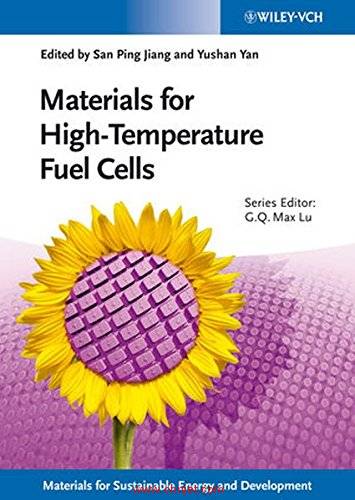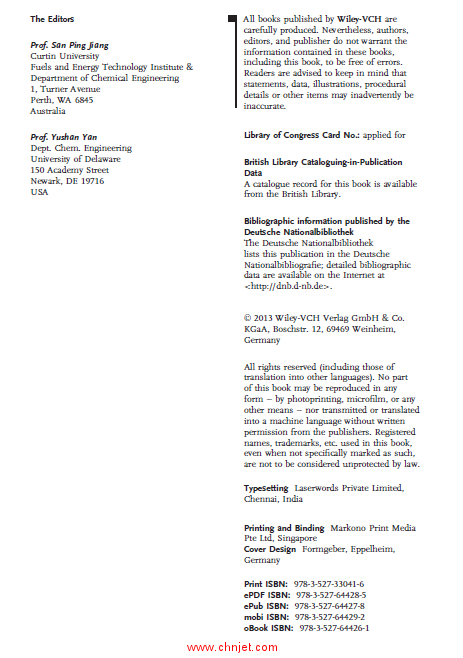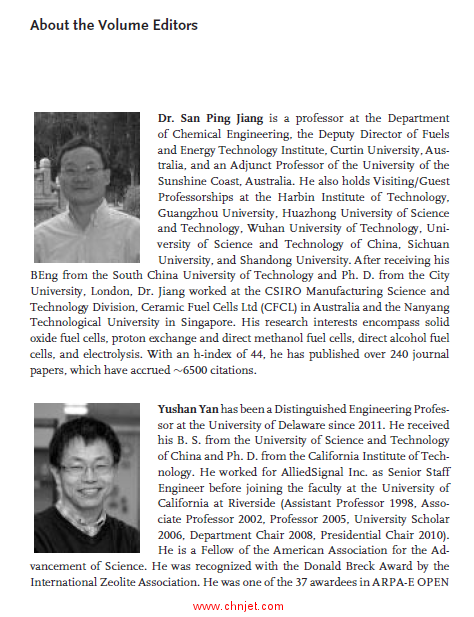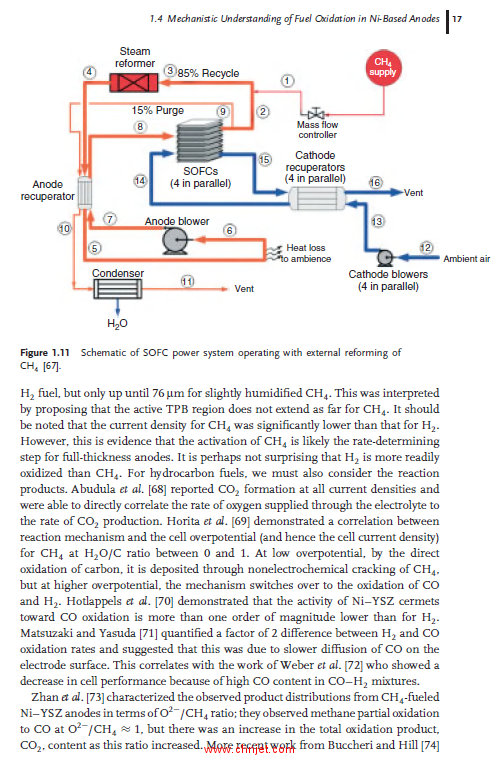马上注册,结交更多好友,享用更多功能,让你轻松玩转社区。
您需要 登录 才可以下载或查看,没有账号?立即注册

×
《Materials for High-Temperature Fuel Cells》
高温燃料电池材料
编辑:
Prof. San Ping Jiang
Curtin University
Fuels and Energy Technology Institute &
Department of Chemical Engineering
Prof. Yushan Yan
Dept. Chem. Engineering
University of Delaware
出版社:Wiley
出版时间:2013年
《Materials for High-Temperature Fuel Cells》

《Materials for High-Temperature Fuel Cells》

《Materials for High-Temperature Fuel Cells》

《Materials for High-Temperature Fuel Cells》

《Materials for High-Temperature Fuel Cells》

目录
Series Editor Preface XIII
Preface XV
About the Series Editor XVII
About the Volume Editor XIX
List of Contributors XXI
1 Advanced Anodes for Solid Oxide Fuel Cells 1
Steven McIntosh
1.1 Introduction 1
1.2 Ni–YSZ Anode Overview 2
1.3 Insights from Real Ni–YSZ Microstructures 7
1.4 Mechanistic Understanding of Fuel Oxidation in Ni-Based
Anodes 9
1.4.1 Hydrogen Oxidation 9
1.4.2 Hydrocarbon Fuels in Ni-Based Anodes 14
1.5 Poisoning of Ni-Based Anodes 19
1.6 Alternative Anode Materials for Direct Hydrocarbon Utilization 21
1.6.1 Electronic Conductivity of Alternative Materials 22
1.6.2 Electrocatalytic Activity of Alternative Anode Materials 28
1.6.3 Poisoning of Alternative Anode Materials 33
1.7 Infiltration as an Alternative Fabrication Method 33
1.8 Summary and Outlook 36
References 37
2 Advanced Cathodes for Solid Oxide Fuel Cells 49
Wei Zhou, Zongping Shao, Chan Kwak, and Hee Jung Park
2.1 Introduction 49
2.2 Cathodes on Oxygen-Ion-Conducting Electrolytes 51
2.2.1 Cathodes on Doped Ceria Electrolytes 52
2.2.1.1 Perovskite 53
2.2.1.2 Double Perovskites 59
2.2.2 Cathodes on Stabilized Zirconia Electrolytes 65
VIII Contents
2.2.2.1 La1−xSrxMnO3-Based Perovskites 65
2.2.2.2 Doped La0.8Sr0.2MnO3 66
2.2.2.3 Cobalt-Containing Cathodes with a Buffering Layer 67
2.3 Cathodes on Proton-Conducting Electrolytes 70
2.3.1 Cobaltite 71
2.3.2 Ferrite 72
2.3.3 Bismuthate 73
2.4 Advanced Techniques in Cathode Fabrication 73
2.4.1 Wet Impregnation 73
2.4.1.1 Alleviated Phase Reaction 74
2.4.1.2 Optimized Microstructure 74
2.4.1.3 Matched Thermal Expansion Coefficient 76
2.4.1.4 Reduced Cost of Metal Catalyst 76
2.4.2 Surfactant-Assisted Assembly Approach 77
2.4.3 Spray Pyrolysis 78
2.5 Summary 79
References 80
3 Oxide Ion-Conducting Materials for Electrolytes 97
Tatsumi Ishihara
3.1 Introduction 97
3.2 Oxide Ion Conductivity in Metal Oxide 98
3.2.1 Fluorite Oxides 98
3.2.1.1 Stabilized ZrO2 99
3.2.1.2 Doped CeO2 103
3.2.2 Perovskite Oxide 106
3.2.3 Perovskite-Related Oxide 112
3.2.4 New Class of Oxide Ion-Conducting Oxide 116
3.3 Electrolyte Efficiency 121
3.4 Strain Effects on Oxide Ion Conductivity 124
3.5 Degradation in Conductivity 127
3.6 Concluding Remarks 129
References 129
4 Proton-Conducting Materials as Electrolytes for Solid Oxide
Fuel Cells 133
Rong Lan and Shanwen Tao
4.1 Introduction 133
4.2 The Principle of Proton-Conducting Oxides 133
4.3 Proton-Conducting Materials for Solid Oxide Fuel Cells 135
4.3.1 BaCeO3- and BaZrO3-Based Proton-Conducting Oxides 135
4.3.2 Other Perovskite-Related Proton-Conducting Oxides 137
4.3.3 Niobate- and Tantalate-Based Proton-Conducting Oxides 138
4.3.4 Proton Conduction in Typical O2− Ion Conducting Materials 138
4.3.5 Other Proton-Conducting Materials 139
Contents IX
4.4 Solid Oxide Fuel Cells Based on Proton-Conducting Electrolytes 140
4.5 Electrode Materials and Anode Reactions for SOFCs Based on
Proton-Conducting Electrolytes 148
4.6 Conclusion 151
References 152
5 Metallic Interconnect Materials of Solid Oxide Fuel Cells 159
Li Jian, Hua Bin, and Zhang Wenying
5.1 Introduction 159
5.2 Oxidation Behaviors of Candidate Alloys 162
5.2.1 Oxidation in Cathode Atmosphere 163
5.2.2 Oxidation in Anode Atmosphere 167
5.2.3 Oxidation in Dual Atmospheres 172
5.2.4 Chromium Evaporation from Metallic Interconnects 175
5.2.5 Compatibility with Cell and Stack Components 178
5.3 Electrical Properties of Oxide Scale 180
5.4 Surface Modifications and Coatings 184
5.4.1 RE and Metallic Element Coatings 184
5.4.2 Perovskite Oxide Coatings 186
5.4.3 Spinel Oxides 189
5.5 New Alloy Development 191
5.6 Summary 194
References 198
6 Sealants for Planar Solid Oxide Fuel Cells 215
Qingshan Zhu, Lian Peng, and Tao Zhang
6.1 Introduction 215
6.2 Glass and Glass–Ceramic Sealants 216
6.2.1 Properties Related to Short-Term Performance 216
6.2.2 Properties Related to Long-Term Performance 222
6.2.3 Sealing Structure Optimization 229
6.3 Mica 230
6.3.1 The Leakage Mechanism of Mica 231
6.3.2 The Effect of Compressive Stress and Differential Pressure on the
Leak Rate of Mica 231
6.3.3 The Effect of Long-Term Aging on the Leak Rate of Mica 233
6.3.4 The Effect of Thermal Cycles on the Leak Rate of Mica 234
6.3.5 The Combined Effect of Aging and Thermal Cycles on the Leak Rate
of Mica 235
6.4 Metal Braze 235
6.5 Composite Sealants 236
6.6 Conclusion 237
Acknowledgment 239
References 239
X Contents
7 Degradation and Durability of Electrodes of Solid Oxide Fuel Cells 245
Kongfa Chen and San Ping Jiang
7.1 Introduction 245
7.2 Anodes 246
7.2.1 Sintering and Agglomeration of Ni Particles 246
7.2.2 Redox Cycling 249
7.2.3 Carbon Deposition 252
7.2.4 Sulfur Poisoning 256
7.2.5 Poisoning by Impurities in Coal Gasification Syngas 260
7.2.6 Silicon Contamination 262
7.3 Cathodes 263
7.3.1 Degradation due to Interfacial Chemical Reactions 263
7.3.2 Microstructure Degradation 265
7.3.3 Chromium Poisoning 269
7.3.4 Contaminants from Glass Sealant 275
7.3.5 Poisoning by Impurities in Ambient Air 276
7.4 Degradation of Solid Oxide Electrolysis Cells 279
7.4.1 Fuel Electrodes 280
7.4.2 Oxygen Electrodes 282
7.5 Summary and Conclusions 286
References 287
8 Materials and Processing for Metal-Supported Solid Oxide
Fuel Cells 309
Rob Hui
8.1 Introduction 309
8.2 Cell Architectures 310
8.3 Substrate Materials and Challenges 313
8.3.1 Requirements for Substrates 313
8.3.2 Properties of Selected Alloys 314
8.3.2.1 Selected Alloys and Roles of Elements 314
8.3.2.2 Oxidation in Oxidizing or Reducing Atmosphere 316
8.3.2.3 Scale Conductivity 318
8.3.2.4 Additional Improvement 320
8.4 Cell Fabrication and Challenges 321
8.4.1 Sintering Approaches 322
8.4.2 Deposition Approaches 326
8.5 Summary 333
References 334
9 Molten Carbonate Fuel Cells 341
Stephen J. McPhail, Ping-Hsun Hsieh, and Jan Robert Selman
9.1 Introduction 341
9.1.1 Development History of the MCFCs 342
9.2 Operating Principle 344
Contents XI
9.3 State-of-the-Art Components 347
9.3.1 Electrolytes 349
9.3.2 Electrolyte Support 351
9.3.3 Anode Materials 352
9.3.4 Cathode Materials 353
9.4 General Needs 354
9.4.1 NiO Dissolution from the Cathode 354
9.4.2 Creeping in the Anode 355
9.4.3 Electrolyte Loss 356
9.4.4 Corrosion of Cell Hardware 357
9.4.5 Electrolyte Optimization 358
9.4.6 Power Density 359
9.4.7 Tolerance to Contaminants 360
9.5 Status of MCFC Systems Implementation 362
References 367
Index 373
专业书籍
下载地址:(回复后可见)
| ![]()